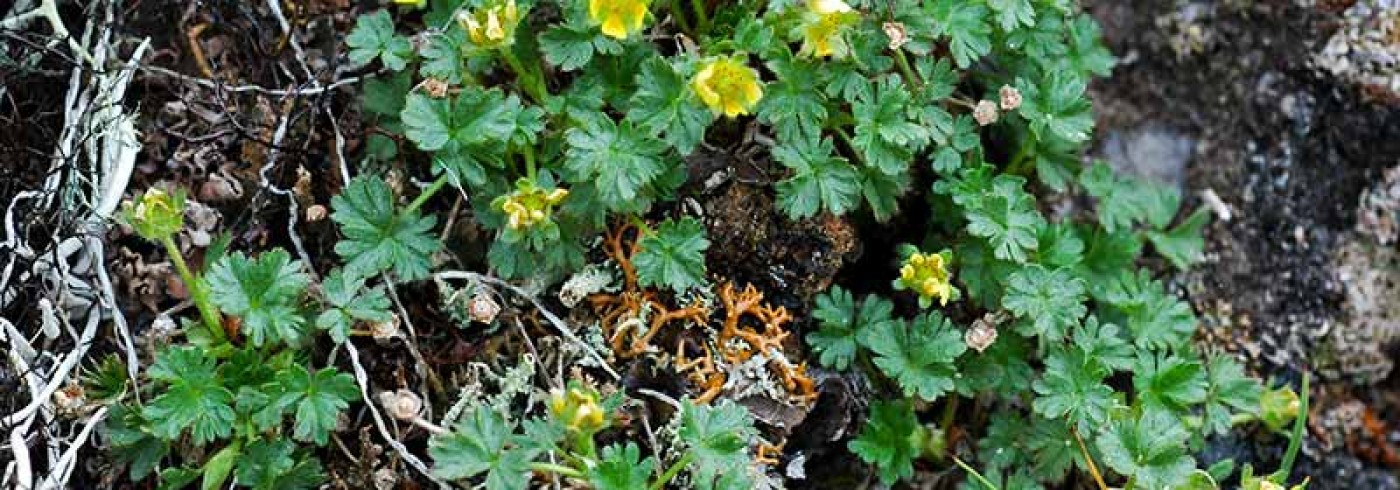Expedition summary: Tundra Northwest – biodiversity in the Arctic tundra
The individual projects in the Biodiversity theme focus on the diversity and evolution of a number of different organisms ranging from microbes, such as bacteria, algae and fungi, to higher plants and animals. The fact that these organisms live together and share a harsh Arctic environment implies that there are questions we may ask ourselves that apply to them all:
- How do species richness and genetic diversity relate to climatic factors along longitudinal and latitudinal gradients in the Arctic?
- Do species richness and genetic diversity reflect the glaciation history or edaphic factors?
- Are there differences in diversity on different scales between groups of organisms?
Habitat description and species richness
An important task for the Biodiversity theme during the expedition has been to compare the species richness of the vegetation along longitudinal and latitudinal gradients. Another task has been to describe the local environment at the sites visited. Physical and biological descriptions of the habitats are helpful when results from biological studies are to be interpreted.
A vegetation analysis was carried out at 14 of 17 sites visited by the expedition. At each of the 14 sites, a mesic and a dry habitat was selected. The occurrence and identity of cryptogams and vascular plants were noted in a number of quadrats randomly distributed within a selected area of the habitats. Lists were made of all the species occurring in each of the quadrats and habitats and the soil properties were studied. These data will provide us with a measure of the diversity and productivity of the areas and will form part of a comparative analysis. The results will also be used to give basic descriptions of the areas in which samples were taken.
The common project has involved most of the participants of the biodiversity and bioclimatology themes as well as a few participants from the plant-animal interaction theme. Some studies, including studies of seed banks and diversity on different scales, are more directly linked to the analysis. Data analysis is being given high priority so that results can be obtained as soon as possible. We hope that participants from all themes will find the descriptions useful.
Genetic diversity and glacial history
Most of the Canadian Arctic, with the exception of an area west of the Mackenzie River on the mainland and parts of Banks Island, was covered by glaciers during the latest glaciation. We are particularly interested in knowing how the organisms colonized the Canadian Arctic after the glaciation.
Did the present-day species have a common refugium, such as the Beringian area in Alaska and eastern Siberia, during the glacial, and did they follow the same route into the formerly glaciated areas when the ice retreated? Or did the different organisms enter from different directions and at different times?
To answer these questions we are bringing living or frozen tissue samples back to our laboratories where we will use molecular methods to determine levels of genetic diversity and to compare its geographical patterns. With these data to hand we intend performing a comparative analysis across a variety of organism groups that represent different communities, life cycles, breeding systems, and dispersal mechanisms.
Dates
June–September 1999
Participants
Chief scientist
Reidar Elven
Botanical Garden and Museum, Oslo University
Norway
Chief scientist
Bente Eriksen
Department of Botany, University of Gothenburg
Sweden
Principal investigator
Manfred Bölter
Institut für Polarökologie, Kiel University
Germany
Principal investigator
Nils Cronberg
Department of Systematic Botany, Lund University
Sweden
Principal investigator
Anders Dahlberg
Department of Forest Mycology and Pathology, Swedish University of Agricultural Sciences
Uppsala, Sweden
Principal investigator
Vadim B. Fedorov
Department of Biology, University of Oslo
Norway
Principal investigator
Daniel Franzén
Department of Botany, Stockholm University
Sweden
Principal investigator
Karl Fredga
Department of Conservation Biology and Genetics, Evolutionary Biology Centre, Uppsala University
Sweden
Principal investigator
Katarina Hedlund
Department of Ecology, Lund University
Sweden
Principal investigator
Anders Hobæk
Norwegian Institute for Water Research
Bergen, Norway
Principal investigator
Eva-Lena Larsson
Botanical Institute, University of Gothenburg
Sweden
Principal investigator
Esther Lévesque
Département de chimiebiologie, Université du Québec á Trois-Rivières
Trois-Rivières, Canada
Principal investigator
Jan-Eric Mattsson
Museum of Evolution, Evolutionary Biology Centre, Uppsala University
Sweden
Principal investigator
Ulf Molau
Botanical Institute, University of Gothenburg
Sweden
Principal investigator
Kristin Palmqvist*
Department of Ecology and Environmental Science, Umeå University
Sweden
Principal investigator
Björn Salomon
Department of Plant Breeding Research, Swedish University of Agricultural Science
Svalöv, Sweden
Principal investigator
Lawrence J. Weider
Biological Station, University of Oklahoma
Kingston, USA
Terry V. Callaghan*
Sheffield Centre for Arctic Ecology
Department of Animal and Plant Sciences, University of Sheffield
United Kingdom
Jean-Yves Charcosset*
Université Paul Sabatier
Toulouse, France
Monique Gardes*
Université Paul Sabatier
Toulouse, France
Dagmar Gormsen
Department of Ecology, Lund University
Sweden
Pål-Axel Olsson*
Department of Microbial Ecology, Lund University
Sweden
Maria Sjögren-Öhrn*
Department of Ecology, Lund University
Sweden
Bengt Söderström*
Department of Microbial Ecology, Lund University
Sweden
Martin Westberg
Department of Systematic Botany, Lund University
Sweden
*Not participating in the expedition

